Since its founding in 1894, the ASU Alumni Association has served as a lifelong connection between the university and its graduates -- locally, nationally and globally. Supporting and honoring ASU traditions like the annual Echo from the Buttes event at "A" Mountain and the signature events that bring the community and university together, the alumni association is a driving force for the advancement of Arizona State University as a New American University.
These words, published in the Territorial Normal School's 1895 catalog, reflect the association’s mission: “It is confidently believed that all graduates of this school will manifest a lively interest in its welfare. Their influence on the schools of the territory is already plainly seen and it will doubtless increase as they increase in experience and numbers.”

History of the Alumni Association
 | 1885Arizona State University's predecessor is created on March 11, 1885, by the 13th Territorial Legislature to train teachers and teach agricultural and mechanical arts. The Territorial Normal School opens its doors for the first time on Feb. 6, 1886. |
 | 1894Territorial Normal School Principal Edgar Storment launches the school's first alumni association, a social club and booster organization. James McClintock, a graduate of the school and later a member of Teddy Roosevelt's legendary Rough Riders during the Spanish-American War, serves as the alumni association's first president. Today's ASU Alumni Association is one of the largest in the country with more than a half-million members. |
 | 1901The alumni association presents its first Benjamin Baker Moeur Awards, named in honor of the pioneering doctor who served as secretary of the Board of Education for Tempe State Teachers College for 12 years before becoming Arizona's fourth governor in 1933. Today, the Moeur Awards are presented annually by the ASU Alumni Association to graduates with the highest academic standing. |
 | 1914Leona M. Haulot, one of 18 students in the Tempe Normal School of Arizona graduating class of 1902, and a teacher at her alma mater for 35 years, is appointed the first alumni association secretary and treasurer. She holds the dual position for one year and again from 1920 to 1942. Haulot also assisted in the establishment of an alumni loan fund for students. |
1922The alumni association is called into action by school President Arthur J. Matthews to lead the charge for an upgrade of the school name to State Teachers College at Tempe, Arizona, and empower it to award the degree of Bachelor of Arts in Education. The association launches "Tempe Normal Clubs" in nearly every community large or small in the state to advance the idea. | |
 | 1925The alumni association's three-plus-year effort to change the school name to reflect its growing stature pays off, and Tempe Normal School becomes Tempe State Teachers College. Today, Arizona State University can trace its groundbreaking successes through the different names of the university: Territorial Normal School, 1885–1896; Tempe Normal School of Arizona, 1896–1903; Tempe Normal School, 1903–1925; Tempe State Teachers College, 1925–28; Arizona State Teachers College, 1928–1945; Arizona State College, 1945–1958; and, by a 2–1 margin of the state's voters, Arizona State University in 1958. |
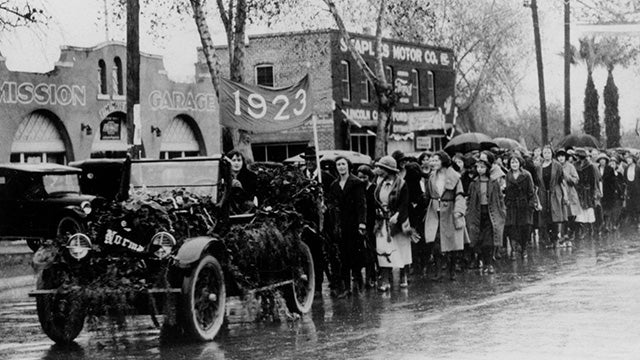 | 1926The alumni association co-sponsors the first Tempe State Teachers College homecoming parade, which includes a "float" of graduates from the 1923 graduating class. A time-honored tradition, ASU Homecoming festivities feature a week-long celebration of Sun Devil spirit through athletic events, fun on- and off-campus activities, academic lectures and discussions, and entertainment options. |
 | 1928College President Matthews presides over a second name change, this time to Arizona State Teachers College. The college catalog notes of the alumni association at the time: "Perhaps the most significant step toward the strengthening of the Alumni Association was the establishment, during the past two years, in many parts of the state, of local Alumni Clubs ... Alumni clubs have already been organized in Bisbee, Douglas, Casa Grande, Phoenix, Globe and Miami." Today, ASU Alumni Association chapters can be found across the country and around the world. |
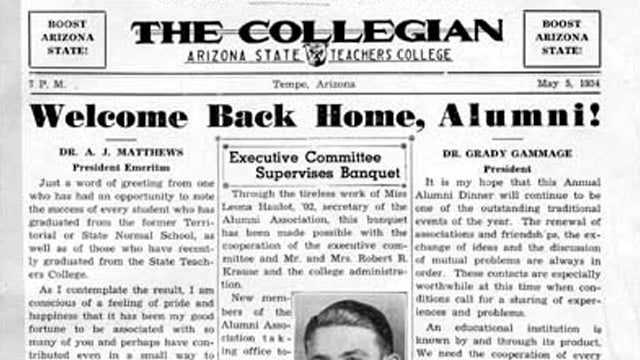 | 1934The alumni association launches several publications aimed at alumni. The first is "The Collegian," printed in May of 1934. Today, "ASU Thrive" is the official ASU Alumni magazine, the state's largest-circulation publication, with a circulation of more than 350,000. |
1939"All loyal alumni take pride in the recent rapid growth and development of their Alma Mater, and it is their desire further to perfect their organization that it may continue effectively to serve her interests." --Arizona State Teachers College, General Catalog, 1938-39 | |
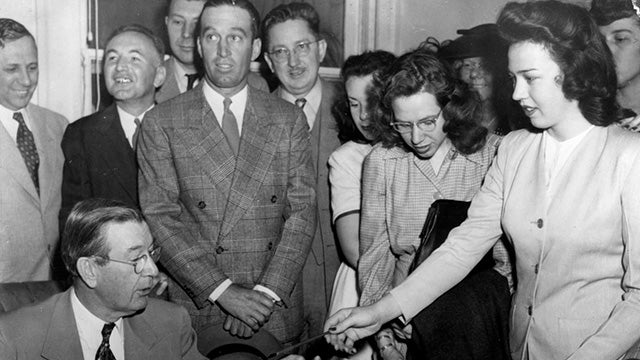 | 1945At the end of World War II, the alumni association participates in a statewide campaign to put all three state institutions of higher education under a single board of regents. The campaign also results in a new name for the teachers college: Arizona State College at Tempe. |
1946The alumni association joins ASC's Bulldog boosters, Phoenix Thunderbirds and other civic groups in a push to upgrade the school's athletics programs. In November, by an 816-196 vote of the ASC student body, a "Sun Devil" mascot, Sparky, is adopted and later created by Walt Disney employee Berk Anthony. The Sun Devils and Sparky make their first appearance in 1947 in a football game against the University of Arizona. Today, Sparky is one of the most recognizable mascots in collegiate sports. | |
1947At the request of ASC President Grady Gammage, James W. Creasman becomes the first full-time executive secretary of the alumni association. Creasman, known as "Mr. ASU," later served as chairman of the campaign to rename Arizona State College to Arizona State University. Today, he is recognized by the ASU Alumni Association through the annual presentation of the James W. Creasman Award of Excellence to an outstanding member of the university community during the annual Founders' Day celebration. Learn more. | |
1948The alumni association establishes its first board of directors under the leadership of Sidney B. Moeur, board president and a graduate of the class of 1914. The association counts 7,000 members and boasts an endowment fund of more than $20,000 for assistance to "worthy students." By 1948, more than 400 students had received aid from the fund. | |
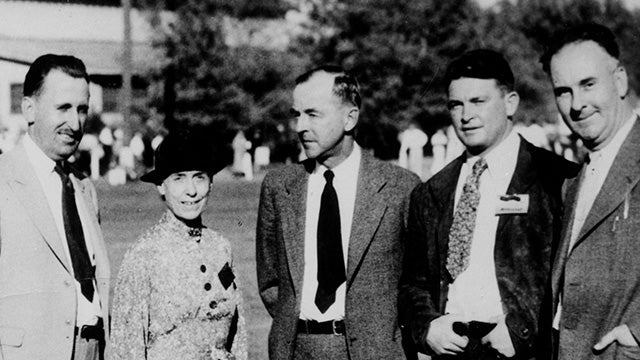 | 1951The alumni association launches a capital campaign to raise "$350,000 in public contributions toward a million dollar Student Union Building for the College." The campaign is led by Charles A. Stauffer, a graduate of the Tempe Normal School in 1901, one-time Phoenix City Commissioner (he approved the first paved road in the city, a three-block stretch of Washington Street) and for nearly two decades the president and publisher of the Arizona Republican (today's Arizona Republic). |
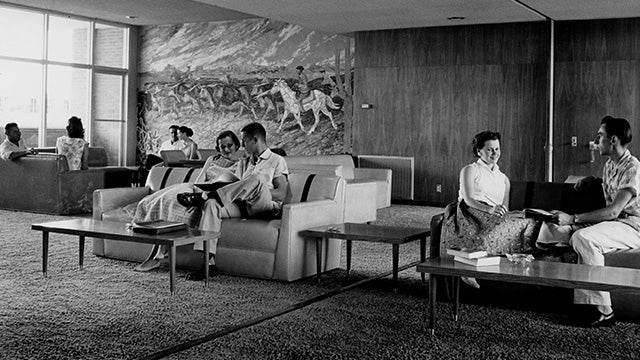 | 1956The Arizona State Memorial Union opens its doors on Feb. 25. Today, the "MU" is a Tempe campus focal point, serving as an educational, cultural, recreational and social-experiences touchstone that has more than doubled in size to 250,000-plus square feet, serving some 15,000 students, faculty and community members daily. |
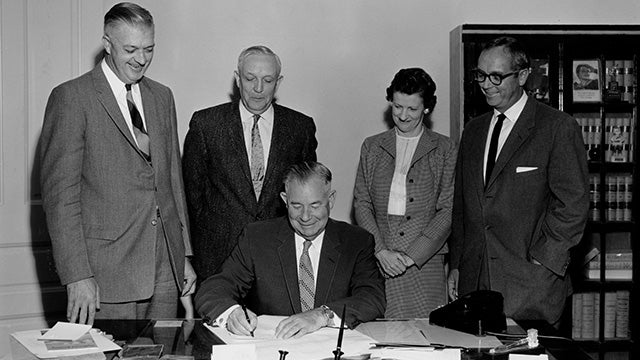 | 1958After a ballot initiative campaign involving the alumni association, students and friends of Arizona State College, voters pass Proposition 200, providing name-changing university status to Arizona State University. The mandate is overwhelming, a 2-1 margin of victory; as university president Grady Gammage noted, "The people -- not the politicians -- have created Arizona State University at last!" |
 | 1960ASU celebrates Founders’ Day for the first time, an event that becomes an annual celebration honoring individuals who exemplify the spirit of the founders of the original Territorial Normal School. At the time, the ASU Alumni Association boasts more than 15,000 members, and it's endowment has grown to $30,000 and assisted more than 500 students have received aid from the fund. |
 | 1964The ASU Alumni Association becomes part of Founders’ Day and recognizes ASU excellence with its first faculty achievement awards. Today, the annual Founders' Day event has grown into a signature university initiative, attracting some 1,000 community leaders and businesses to a dinner affair honoring faculty, alumni and philanthropists who have help advance the country's No. 1 "most innovative" university as recognized by U.S. News & World Report in 2016, 2017, 2018 and 2019. |
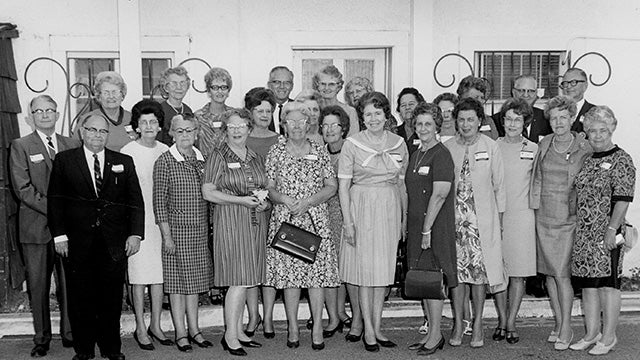 | 1969The alumni association recognizes its first college-based alumni group, composed of graduates of the ASU College of Nursing. Today, the ASU Alumni Association boasts national and international chapters and academic and special interest chapters to serve and connect with more than a half-million Sun Devil alumni. |
1978The alumni association launches a paid membership program for the first time, offering both annual and lifetime opportunities for alumni and supporters of the university. At the time, "some 86,000 graduates are on the alumni association's files," according to the university's general catalog. Today, all ASU degreed alums are members of the ASU Alumni Association: a powerful network of more than 500,000 Sun Devils across the globe. | |
 | 1985ASU celebrates its 100th anniversary. The alumni association counts 125,000 members and, as noted in the year's general catalog, "strives to promote effective interest in and loyalty to Arizona State University on the part of alumni and the general public." |
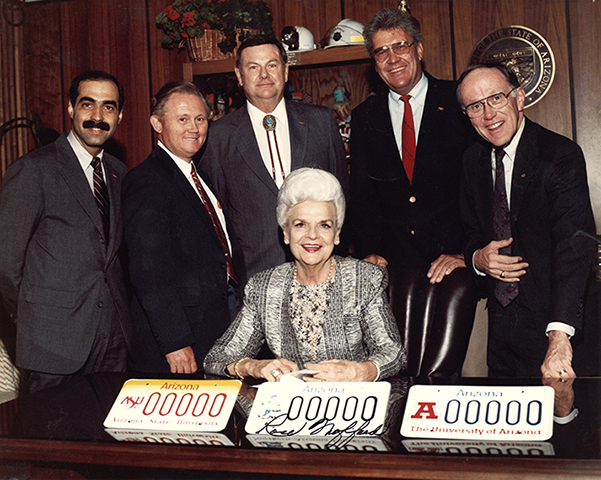 | June 1988Arizona Gov. Rose Mofford signs legislation creating a collegiate license plate program for Arizona's three state universities to fund academic scholarships. The funds generated by sales of the ASU collegiate license plate—which originally featured Sparky against a white backdrop—fund Medallion Scholarships available to students who graduate from Arizona high schools. Officials from ASU spearheaded the initiative to create the state’s collegiate license plate program. The ASU license plate has gone through several redesigns throughout the years, and the university also has collegiate plates in Maryland, Pennsylvania and Texas. |
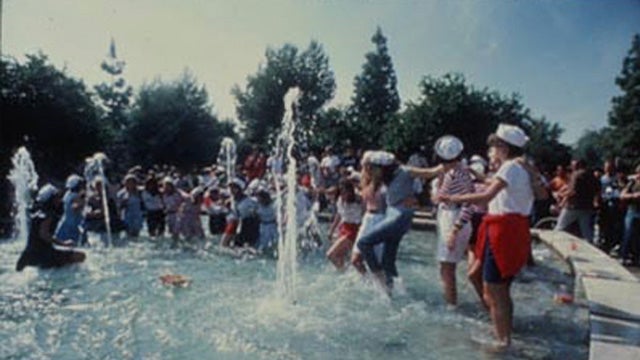 | 1998–99The alumni association is a driver in a comprehensive, $5.7 million refurbishment project for Old Main, which provides the building with interior and exterior features faithful to the period of its construction. Dedicated in February 1898, Old Main was originally all classrooms on the second and third floor, with an auditorium (the Assembly Hall) on the upper floor and a library on the lower level. Today, in addition to being the home of the ASU Alumni Association, Old Main boasts multiple conference rooms, the Basha Library, Tooker Board Room and the Carson Ballroom -- each available for university and community use. |
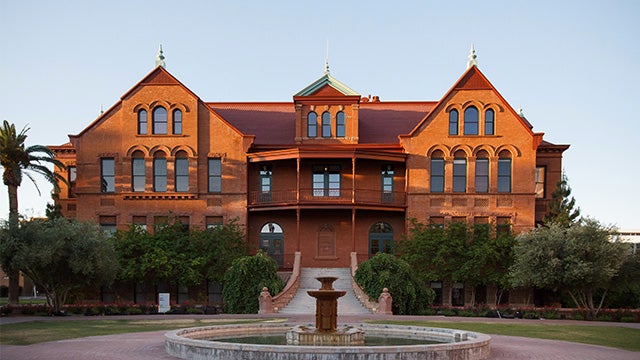 | 2000The reimagination of Old Main at ASU is completed and the university’s oldest building is rededicated. Today, Old Main is the strongest tangible link among generations of ASU alumni. Leave your mark on the historic ASU Tempe campus with a personalized plaque or brick paver. |
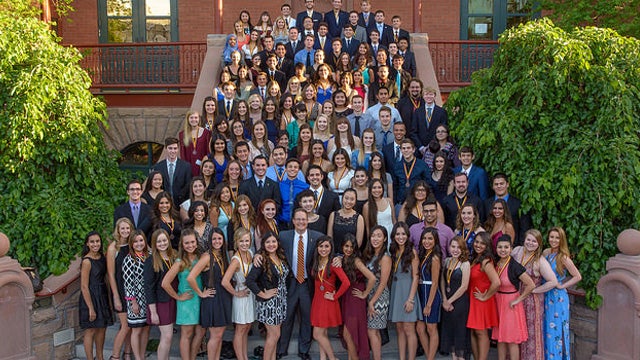 | 2006The ASU Alumni Medallion of Merit scholarship program, originally launched in the 1960s, is reconstituted as the Medallion Scholarship Program and becomes the association’s signature schoolarship initiative. Medallion scholars successfully combine components of leadership, scholarship and service and today are supported in part by the ASU Medallion Scholars Alumni Club. |
 | 2007Sun Devil Generations, a program for ASU youngsters and families, is launched. Reflecting the lifelong connections encouraged by the ASU Alumni Association, Generations is specifically designed to engage young Sun Devils in innovative, exciting and entertaining ways. |
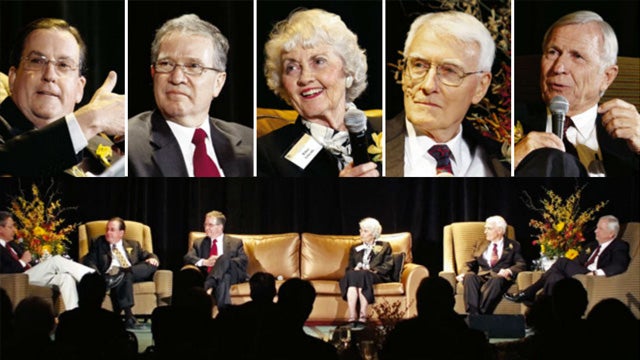 | 2008On the 50th anniversary of the successful 1958 Arizona State University name change campaign, members of that year’s graduating class are honored by the ASU Alumni Association at the annual Founders’ Day celebration. In a busy year for the association, the now-signature Legends Luncheon is launched and football season’s popular Sparky’s Touchdown Tailgates makes its road game debut for out-of-town, out-of-state Sun Devil grads. |
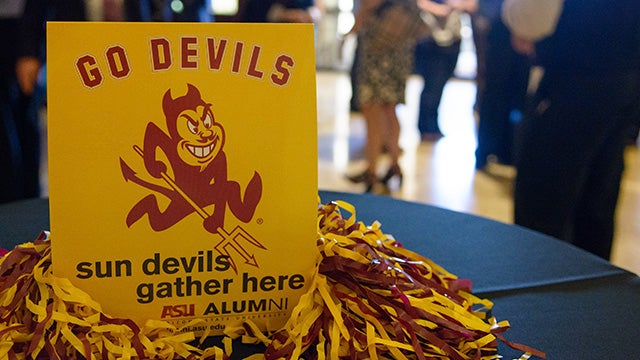 | 2009Alumni career and professional development services are enhanced for university alumni through the introduction of the Maroon & Gold networking events nationwide and Women In Business networking events held in the Phoenix metropolitan area. Additionally, the alumni association begins offering focused professional development programs, featuring discussions, presentations and guidance in areas such as leadership, goal setting, résumé writing, career management and more. |
 | 2010The Legacy Scholarship program is launched in support of Sun Devil families; relatives of ASU alumni are eligible to apply for the scholarship. In addition to continuing the family tradition of an ASU education, selected scholars demonstrate evidence of academic success, strong commitment to community service and university involvement, and achievement of personal and educational goals. |
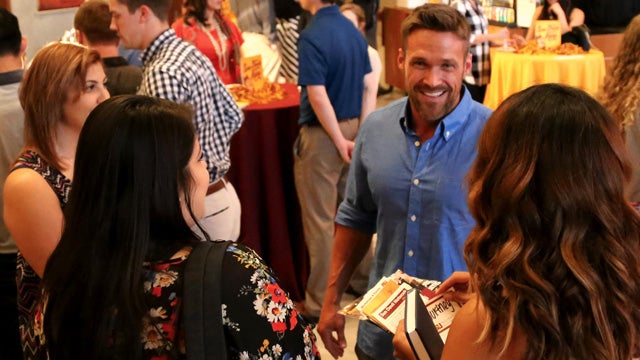 | 2014The Phoenix Business Journal recognizes the ASU Alumni Association as the top networking organization in the Greater Phoenix area, noting its history, size and number of networking event opportunities. The association provides its members with career and professional development services for life, including advising, career posting resources and the ASU Mentor Network. |
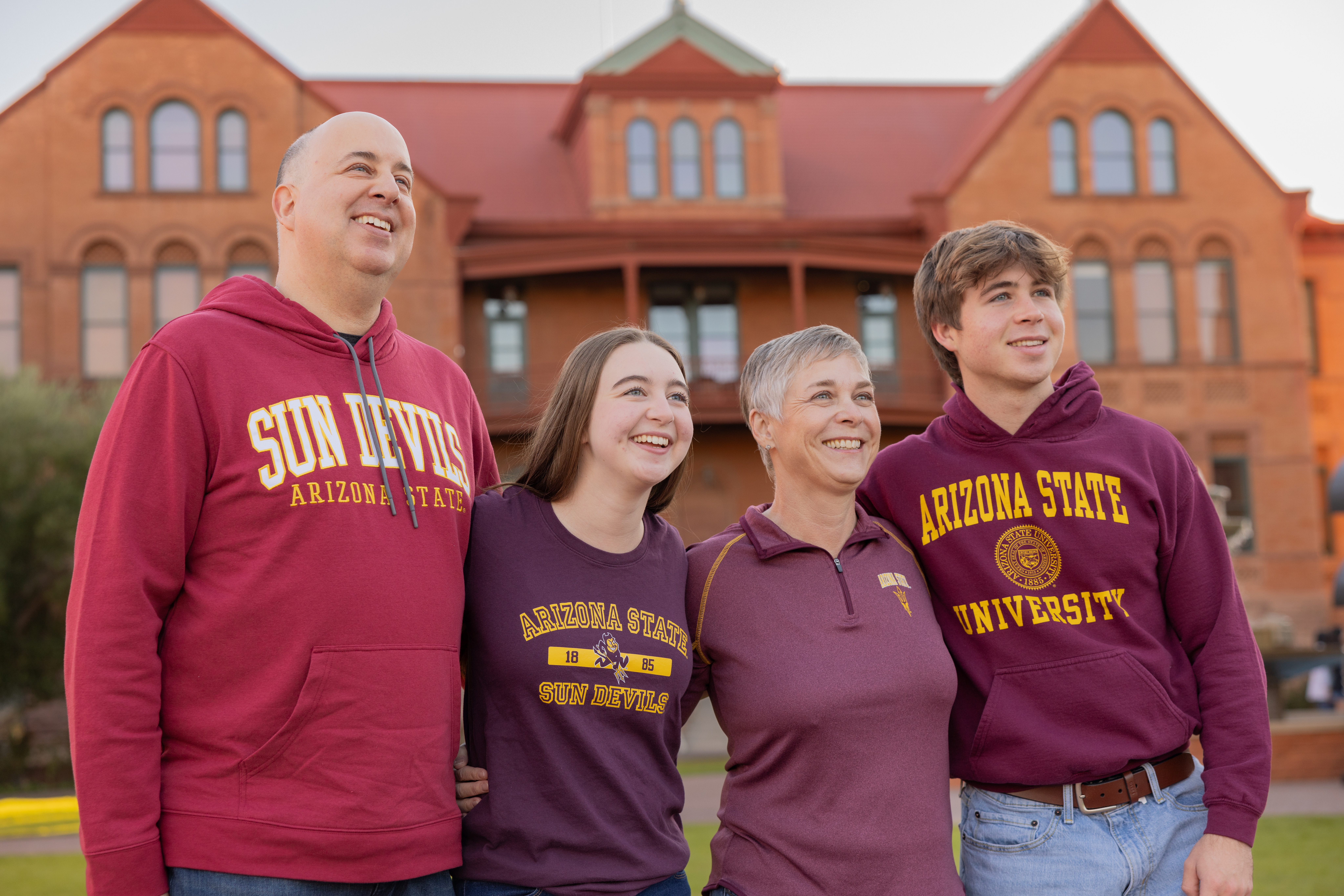 | 2016The ASU Alumni Association announces that lifelong membership is now free for all grads - no dues required. This change was implemented to strengthen the bond between ASU and its extensive alumni network. Benefits of membership include career services, access to exclusive events and discounts. |
 | 2018The ASU Leadership Institute is unveiled by ASU Alumni. The unique program is a structured, nine-month opportunity focused on the university and its institutional objectives in the areas of excellence, access, impact and the transcendent value of higher education. The first cohort includes 21 graduates of ASU, from 1974 to 2017. |
 | 2024With more than 640,000 members, the ASU Alumni Association was ranked the No. 1 largest Phoenix-area networking association by the Phoenix Business Journal for the 11th consecutive year. There are 338,607 ASU alumni who reside in Arizona, allowing for networking opportunities that complement the association’s mission of fostering lifelong connections. |